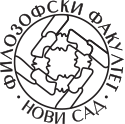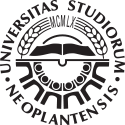15SFSF015 - History of the Serbian Language 1
| Course specification | ||||
|---|---|---|---|---|
| Course title | History of the Serbian Language 1 | |||
| Acronym | 15SFSF015 | |||
| Study programme | Serbian Philology: Serbian Language and Literature | |||
| Module | ||||
| Type of study | first degree undergraduate academic studies | |||
| Lecturer (for classes) | ||||
| Lecturer/Associate (for practice) | ||||
| Lecturer/Associate (for OTC) | ||||
| ESPB | 5.0 | Status | ||
| Condition | Oblik uslovljenosti | |||
| The goal | The objective of the course is to acquaint students with: (1) the “external” history of the Serbian language, (2) the principles and methodology of historical phonology, and (3) phonological changes in Serbian. | |||
| The outcome | After the course the student is able to: (1) know what are the relevant research questions in historical phonology, (2) recognise and interpret the external and internal motivation of phonological changes in Serbian, (3) explain the phonological phenomena in Old Serbian texts, (4) diachronically explain the modern Serbian phonological phenomena. | |||
| Contents | ||||
| Contents of lectures | 1. Outlines of the external history of the Serbian language (The Settlement of the Slavs in the Balkan Peninsula; Pre-Slavic language substratum in the Balkans; Eastern–Western division of the South Slavic language region; The Balkan Sprachbund; Divisions within South-Western Slavic language subregion; The Serbian language and Shtokavian); 2. Sources for studying the history of the Serbian language; 3. Key questions for historical phonology (Types of sound changes; Structural causes of sound change; Sound changes caused by language contact; The influence of syllable structure); 4. The main changes in the vowel system from Late Proto-Slavic to Modern Serbian (The common initial South Slavic vowel system; The first stage of the vowel changes; The consequences of loss of weak yers: fleeting yer, secondary yer, assimilation of voice, assimilation by place of articulation, simplification of consonant groups, etc.; The second stage of the vowel changes); 5. The main changes in the prosodic system from Late Proto-Slavic to Modern Serbian (The common initial South Slavic prosodic system; The Serbian accent shifts and their consequences); 6. The main changes in the consonant system from Late Proto-Slavic to Modern Serbian (The common initial South Slavic consonant system; Causes and consequences of consonant changes: the sonorant system, the plosive system, the fricative system, the affricate system; Palatalizations; Iotations). | |||
| Contents of exercises | Reading and phonological analysis of Old Serbian texts | |||
| Literature | ||||
| ||||
| Number of hours per week during the semester/trimester/year | ||||
| Lectures | Exercises | OTC | Study and Research | Other classes |
| 2 | 2 | |||
| Methods of teaching | (1) Lecture, (2) class discussion, (3) presentation, (4) problem solving | |||
| Knowledge score (maximum points 100) | ||||
| Pre obligations | Points | Final exam | Points | |
| Activites during lectures | 5 | Test paper | ||
| Practical lessons | 5 | Oral examination | 30 | |
| Projects | ||||
| Colloquia | 60 | |||
| Seminars | ||||

